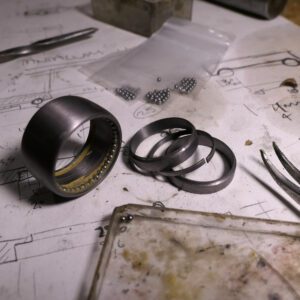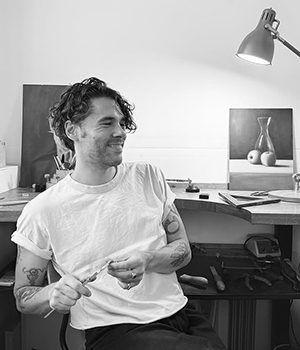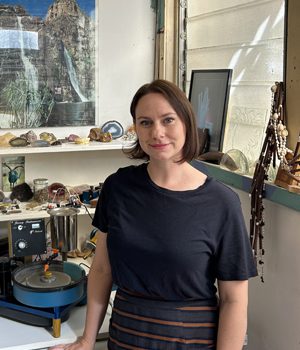In Conversation with Sean O’Connell

For more than two decades, Sean O’Connell has created jewellery that blends industrial precision with organic movement. Inspired by everything from a machinist grandfather to Tarkovsky films and the Tasmanian wilderness, his work explores strength, motion, and transformation. In this interview, we explore Sean’s inspirations, creative process, and the philosophy behind his dynamic designs.
What inspired you to create such dynamic jewellery? How did the concept of these pieces come about?
It has been over 20 years since I started making jewellery and there are still so many inspirations. One of the first big pieces I remember making was an articulated necklace in memory of my grandfather who had recently passed away – he was a German machinist and a very precise man, so it was quite an ask to make a piece about him! That necklace was all about strength, but with flexibility. As a moving piece with lots of mechanical joints, made out of stainless steel, it was strong, yet sinuous like a snake. I have always loved movement, and I also love the idea of jewellery as an amulet, to help us navigate the world. So when I started working with balls, and creating bearings as ring forms, it made so much sense to me. I love the feeling on the finger, the fidgety quality of wearing them, but most of all, I love how a ball bearing ring can help me move smoothly through the most difficult of days.

Your work incorporates industrial materials like tantalum and ball bearings. What draws you to these materials, and how do you think they enhance the experience for the wearer?
I love materials of all kinds. In my home I have meteorites, all sorts of strange wood samples, shell collections, random stones and bones, and all manner of things. A lot of materials are connected to certain places, like precious bits of wood and stone from the land where I live. The materials I use in my jewellery are often very practical, trying to find something strong enough to make kinetic moving pieces out of – such as stainless steel or titanium.
“But some materials, like tantalum, are more of a love affair – its so easy to fall for that rich stormy hue, its dense weight – it’s a very lush material. I think wearing tantalum is very special – it has quite a strong presence to it.”
You mention that your designs fall somewhere between being jewellery and tools. How do you define this boundary?
I guess it feels like that to me partly because a lot of my jewellery moves, and also as I mentioned, that I think of jewellery as an amulet or aid to help us through the day. To me a tool helps you do something, and I think that when jewellery works best, it helps us make our daily lives better, and richer.
How do your inspirations of Andrei Tarkovsky, Pan Sonic, and Dr. Seuss shape the creative process of your work?
I love movies, music, and books – they give me lots of inspiration. The minimal yet sensual feel of Tarkovsky’s movies, where nothing is quite as it seems, has a profound effect on all the things I make. And you can see from my jewellery how much I love a good greyscale aesthetic. Music, of all sorts, is a constant source of joy too, as is sitting down with some Dr Seuss tongue twisters and a pot of coffee in the sunshine and wasting some time giggling with friends or by myself.

You’ve mentioned that your work is heavily influenced by nature. In what ways do you translate nature into your jewellery designs?
My jewellery is very abstract, so it may not be apparent how the natural world inspires it. When I walk through the forests or the moors around me, I often look at the way things grow and form, such as the way trees branch, the junction where the wood grows around over time, the force of the weight of the limb, as it grows and thickens, changing to support itself, reacting to wind and snow and the direction of light…. The underlying sense of how things form is fascinating. The natural world is so dynamically balanced, constantly in flux, and watching it helps me understand how to form materials more sensitively, how to simply imagine and create form, how to support those forms on the body, and also how to create the movements for more demanding kinetic pieces.
How has relocating to Tasmania inspired your creative process?
I am totally in love with the natural world here in Tasmania, especially the highland plateau where I live. Since moving down here 7 years ago, I have explored many different areas, but the Central Plateau is my favourite place, and where I live. It can be cold – down to minus 14 in winter – but it is so clear, wide, open, and serene. There is no electricity here, no postal service, and during the colder months it can be very quiet. It’s otherworldly. I think that the pristine uncompromising landscape influences the work that i make, and the way I see the world. I feel very lucky to have ended up here.

You discuss the idea of jewellery as a “symbol of transformation”. Why is this important to you?
I think jewellery can be so many different things for all of us, but for me the most important way it works is aspirationally – as a touchstone for something I want in my life. That can be a greater sense of simplicity, or beauty, or a clearer vision of a complex world. These are things that I seek, and court, in my own life. It comes back again to the idea of the amulet – an object that acts like a promise of change – a symbol of transformation that can help us find a better way of being.
What role does imperfection play in your making? Do you ever embrace flaws in your work, or do you strive for absolute precision?
Gosh – I wish I could play more with texture and imperfection – I always get carried away making everything so clean and shiny! While I have tried occasionally to embrace flaws and be less controlled, and play more with texture, I usually end up making a mess! So I clean it all up and go back to the polishing wheel. Its hilarious that my works are so clean and smooth, because my workshop always seems to be a total mess! Maybe my jewellery making just fulfils a need in my life for something that is sorted and under control – something small and shiny and neat!

Your process involves both machinery and traditional handcrafting. How do you balance technology with the unpredictable and tactile nature of working by hand?
I use my manually operated metal lathe quite a lot when making kinetic pieces, so it is always a joy to get the back into direct contact with the metal through using files, hammers, saws and sandpaper. There is a satisfaction in both ways of working – with machine, and more closely with hand tools. There is a direct feedback that is very special when working by hand, whereas when I work on the lathe, even though it is all manually controlled, it takes longer to receive that feedback – the design and material feedback happens after the work is finished, in between iterations of a design, so i takes a lot longer to learn how to make something, rather than having that immediate feedback and understanding with hand working, as you are working the piece. The two modes complement each other in some kind of satisfying way for me.
Tell us about the golden alpaca…
I love my golden alpaca – his name is Albert. I cast this tiny golden alpaca from scrap when I was studying, and he has adorned every workshop I have had. He is now at one end of my workshop, amid a sea of orange, watching me hammer away, overlooking the great lake, and soaking up the afternoon sun.



